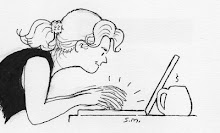Websites like Jeremiah's Vanishing New York document the domino fall of mom-and-pop stores and longtime watering holes, killed by $30,000-per-month rents and replaced with TD Bank branches and designer boutiques. (In the interests of full disclosure and blatant promotion, I should mention that Jeremiah covered My Beloved, whose Stan Mack's Real Life Funnies comic strip in the Village Voice Jeremiah describes as "...an invaluable time capsule of two decades when New York City was still a wild, weird, creative place filled with people who, at the very least, had something interesting to say.")
A niche site, ...and now it's a f***ing froyo place, hilariously specializes in the transformation of locals businesses into...you got it. Meanwhile the glorious Ephemeral New York celebrates the old city—before MetroCards replaced subway tokens, before froyo places replaced everything.
 | |||||
| Boy Leaping Into Hudson River by Ruth Orkin, via Ephemeral New York |
Even I, a relative newcomer at four-and-a-half years in, get snarly when I look out my window and see cranes on the old St. Vincent's Hospital site, now erecting a behemoth of "five unique addresses and five townhouses nestled together in the West Village"—for cozy nestling prices ranging from $2.195 million (for 892 square feet) up to $19.15 million. With, no doubt, proximity to a frozen yogurt place.
 |
| In the gloom of a storm, the cranes of "The Greenwich Lane" rise above the Village. |
I know the rule of thumb: The Golden Age of New York was 20 years before whenever you got here. And I know that New York has never stood still. Still, it's feeling lately like the pace of change has gone to lightspeed—closures-building-closures-building-CLOSURES!-BUILDING!—with wads of new money greasing the skids.
But once in a while, you get to reach through a tear in the fabric and touch old New York. As on July 4, when we made a last-minute decision to have dinner at Fraunces Tavern before watching fireworks over the East River. Though it's been through many permutations through the years, the original building dates to pre-Revolutionary times, and it was here that George Washington bid farewell to his officers in 1783, as he prepared to resign his commission from the Continental Army.
 |
| Fraunces Tavern, where 1719 meets 2014. |
By the time we finished dinner, we couldn't get anywhere near the East River for fireworks, so we ended up in Battery Park behind the glassy new Staten Island Ferry building. As we watched the fireworks rise up over the roof, I was drawn to the quote on the wall inside the building—we could only see its final phrase:
It turns out to be two lines from Edna St. Vincent Millay's poem Recuerdo:
We were very tired, we were very merry,On Sunday, we joined Ms. Millay and went back and forth on the ferry. It was hot and humid—no surprise in July—and as I often do during summer months here, I was trying to imagine exactly how unbearable it was in New York in the days before air conditioning.
We had gone back and forth all night on the ferry.
The New Yorker recently re-posted on its website a piece by Arthur Miller that had appeared in a 1998 issue on this very topic. Writing about an "extraordinarily hot September" in the late 1920s, Miller said:
Even through the nights, the pall of heat never broke. With a couple of other kids, I would go across 110th to the Park and walk among the hundreds of people, singles and families, who slept on the grass, next to their big alarm clocks, which set up a mild cacophony of the seconds passing, one clock’s ticks syncopating with another’s...
...Broadway had open trolleys with no side walls, in which you at least caught the breeze, hot though it was, so that desperate people, unable to endure their apartments, would simply pay a nickel and ride around aimlessly for a couple of hours to cool off.
 |
| Trolley at Broadway and Bleecker, 1917 (c) Culver Pictures |
From 1897 until 1972, you could also ride the Staten Island Ferry for a nickel—crisscrossing New York harbor, hanging on the railings, just to feel fresh air on your face. Today, miracle of miracles, the Ferry is free for foot passengers, and on a muggy July afternoon, we were two of them.
 |
| The view from our outside bench on the middle deck of the Guy V. Molinari. |
Some things never change:
 |
Then, an hour after we'd started, we were back again—now a little cooled, a lot windswept—facing new-old New York, and greeting the ghosts of Arthur Miller and Edna St. Vincent Millay and generations of hot and sweaty New Yorkers.
 |
| On the Staten Island Ferry 1956 by David Moore |


















